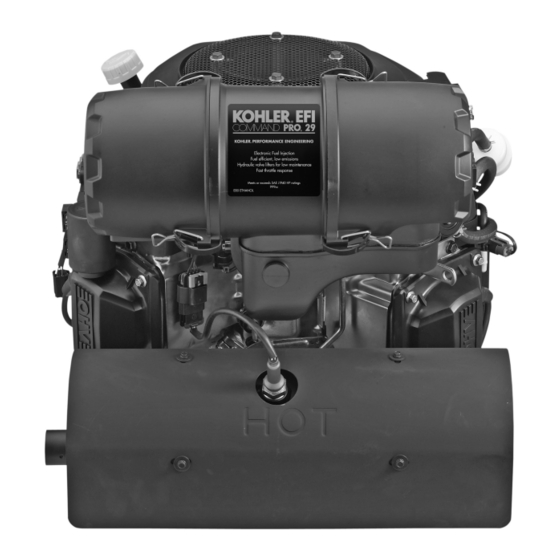Kohler Command PRO ECV749 Instrukcja obsługi - Strona 5
Przeglądaj online lub pobierz pdf Instrukcja obsługi dla Silnik Kohler Command PRO ECV749. Kohler Command PRO ECV749 21 stron. Vertical crankshaft
Również dla Kohler Command PRO ECV749: Instrukcja obsługi (8 strony)

Fuel Recommendations
Explosive Fuel can cause fires
and severe burns.
Do not fill the fuel tank while the
engine is hot or running.
Gasoline is extremely flammable and its vapors can explode
if ignited. Store gasoline only in approved containers, in
well ventilated, unoccupied buildings, away from sparks or
flames. Do not fill the fuel tank while the engine is hot or
running, since spilled fuel could ignite if it comes in contact
with hot parts or sparks from ignition. Do not start the
engine near spilled fuel. Never use gasoline as a cleaning
agent.
General Recommendations
Purchase gasoline in small quantities and store
in clean, approved containers. A container with a
capacity of 2 gallons or less with a pouring spout is
recommended. Such a container is easier to handle
and helps eliminate spillage during refueling.
Do not use gasoline left over from the previous season,
to minimize gum deposits in your fuel system and to
ensure easy starting.
Do not add oil to the gasoline.
Do not overfill the fuel tank. Leave room for the fuel to
expand.
Fuel Type
For best results use only clean, fresh, unleaded
gasoline with a pump sticker octane rating of 87
(R+M)/2 or higher. In countries using the Research
Octane Number (RON), it should be 90 octane
minimum. Leaded gasoline is not recommended and
must not be used on EFI engines or on other models
where exhaust emissions are regulated.
Gasoline/Alcohol blends
Gasohol (up to 10% ethyl alcohol, 90% unleaded
gasoline by volume) is approved as a fuel for Kohler
engines. Other gasoline/alcohol blends including E20
and E85 are not to be used and not approved. Any
failures resulting from use of these fuels will not be
warranted.
Gasoline/Ether blends
Methyl Tertiary Butyl Ether (MTBE) and unleaded
gasoline blends (up to a maximum of 15% MTBE by
volume) are approved as a fuel for Kohler engines.
Other gasoline/ether blends are not approved.
Operating Instructions
Also read the operating instructions of the equipment this
engine powers.
WARNING
Pre-Start Checklist
1. Check oil level. Add oil if low. Do not overfill.
NOTE: Engines are shipped without oil. Do not start
engine with no or low oil. This will cause
damage to the engine and will not be covered
under warranty.
2. Check fuel level. Add fuel if low.
3. Check cooling air intake areas and external
surfaces of engine. Make sure they are clean and
unobstructed.
4. Check that the air cleaner components and all
shrouds, equipment covers, and guards are in
place and securely fastened.
5. Check that any clutches or transmissions are
disengaged or placed in neutral. This is especially
important on equipment with hydrostatic drive.
The shift lever must be exactly in neutral to
prevent resistance which could keep the engine
from starting.
Carbon Monoxide can cause
severe nausea, fainting or death.
Avoid inhaling exhaust fumes, and
never run the engine in a closed
building or confined area.
Engine exhaust gases contain poisonous carbon monoxide.
Carbon monoxide is odorless, colorless, and can cause death
if inhaled. Avoid inhaling exhaust fumes, and never run the
engine in a closed building or confined area.
Starting
1. Place the throttle control midway between the
SLOW and FAST positions.
2. Start the engine by activating the key switch.
Release the switch as soon as the engine starts.
a. Turn the key switch to the ON position for
one minute. Allow the fuel pump to cycle
and prime the system. Turn the key switch
OFF.
b. Turn the key switch to the START position,
crank and start engine.
c. If the engine fails to start, repeat steps a
and b. If the engine does not start after
two priming intervals, contact your Kohler
Engine Service Center for further assistance.
NOTE: Do not crank the engine continuously for
more than 10 seconds at a time. If the engine
does not start, allow a 60 second cool down
period between starting attempts. Failure
to follow these guidelines can damage the
starter motor.
WARNING
5
